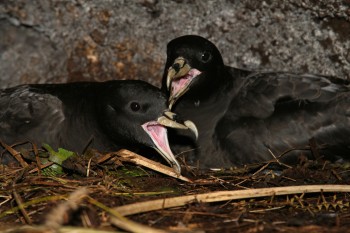Rachel Buxton (Department of Fish, Wildlife and Conservation Biology, Colorado State University, Fort Collins, USA) will host a discussion on behalf on the World Seabird Union on Twitter (#seabirdersaturday) this coming Saturday, 18 July, from 1530-1730 GMT on acoustic monitoring in seabirds (including burrowing species – of which seven petrels and shearwaters are ACAP-listed) as described below.
“Seabirds are among the most threatened group of marine animals. Accordingly, over the past few decades, seabird conservation efforts have increased; including the eradication of harmful introduced predators from breeding sites and implementation of fisheries by-catch mitigation. Population monitoring has therefore become especially important, to inform adaptive management by measuring the outcome of conservation efforts and to provide estimates for trajectory models under predicted future conditions. Despite their threat status and the importance of long-term monitoring, seabird population estimates remain scarce because of the financial and logistical challenges associated with accessing remote island breeding sites. Moreover, many seabirds have cryptic nesting behavior, including below-ground nesting and nocturnal colony attendance, precluding the use of conventional monitoring techniques.
More recently, passive acoustic recorders and automated acoustic analysis have received wide attention as powerful tools to monitor vocalizing wildlife. Colonial seabirds lend themselves to acoustic monitoring, as their aggregated distribution reduces the spatial coverage required for monitoring and the number of vocalizations have [sic] been linked to relative abundance. Moreover, the burgeoning field of acoustic ecology examines the relationship between the soundscape (combination of sounds from an environment) and ecosystem functioning. In this way, acoustic monitoring provides an opportunity to not only monitor seabird populations, but also the broader island landscape” (click here).

White-chinned Petrels, photograph by Dave Boyle
Selected Literature:
Borker, A.L., McKown, M.W., Ackerman, J.T, Eagles-Smith, C.A., Tershy, B.R. & Croll, D.A. 2014. Vocal activity as a low cost and scalable index of seabird colony size. Conservation Biology 28: 1100-1108.
Buxton, R.T. & Jones, I.L. 2012. Measuring nocturnal seabird activity and status using acoustic recording devices: applications for island restoration. Journal of Field Ornithology 83: 47-60.
Buxton, R.T., Major, H.L., Jones ,IL. & Williams, J.C. 2013. Examining patterns in nocturnal seabird activity and recovery across the western Aleutian Islands, Alaska, using automated acoustic recording. The Auk 130: 331-341.
Blumstein, D.T., et al. 2011. Acoustic monitoring in terrestrial environments using microphone arrays: applications, technological considerations and prospectus. Journal of Applied Ecology 48: 758-767.
Oppel, S., Hervias, S., Oliveira, N., Pipa, T., Silva, C., Geraldes, P., Goh, M., Immler, E. & McKown, M.W. 2014. Estimating population size of a nocturnal burrow-nesting seabird using acoustic monitoring and habitat mapping. Nature Conservation 7: 1-13.
Pijanowski, .B.C., Villanueva-Rivera, L.J., Dumyahn, S.L., Farina, A., Krause, B.L., Napoletano, B.M., Gage, S.H. & Pieretti, N. 2011. Soundscape ecology: the science of sound in the landscape. Bioscience 61: 203-216.
John Cooper, ACAP Information Officer, 14 July 2015

 English
English  Français
Français  Español
Español